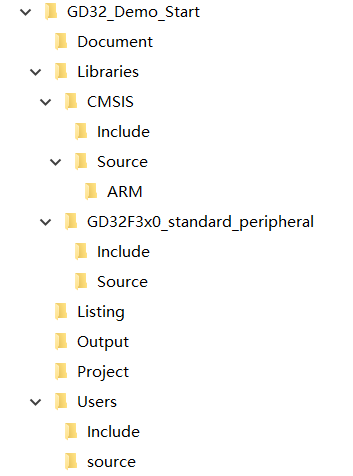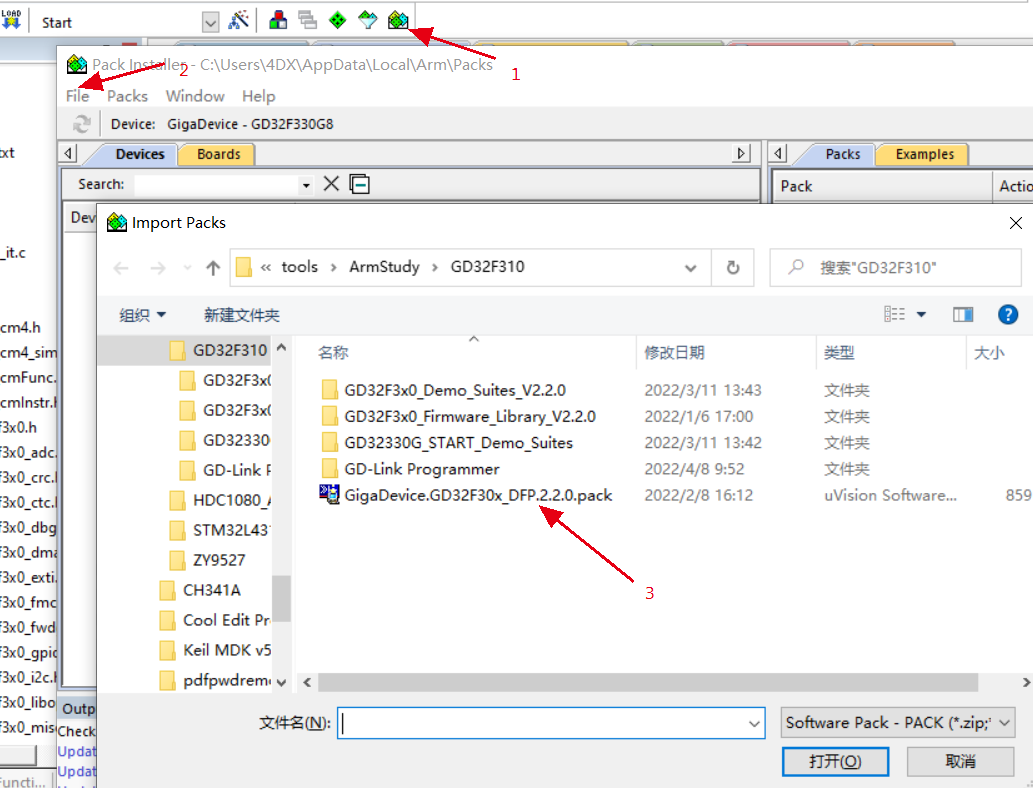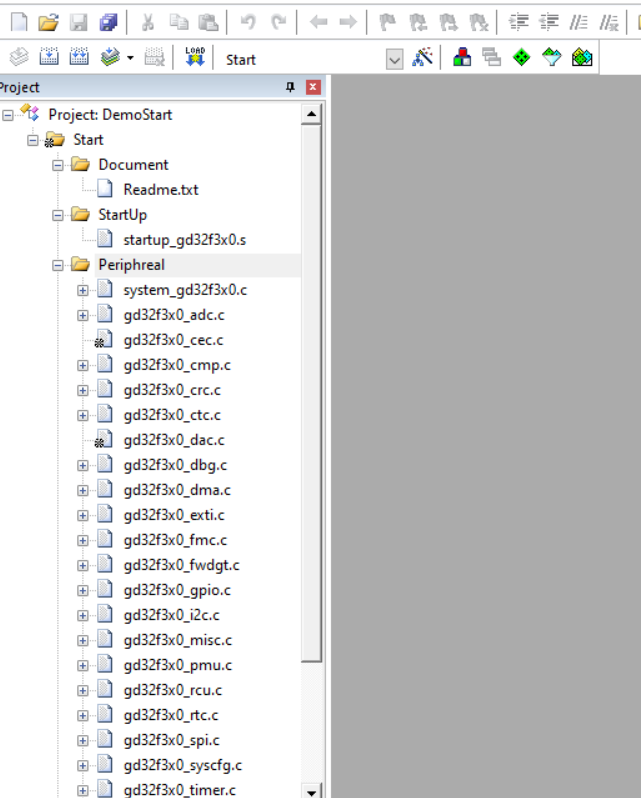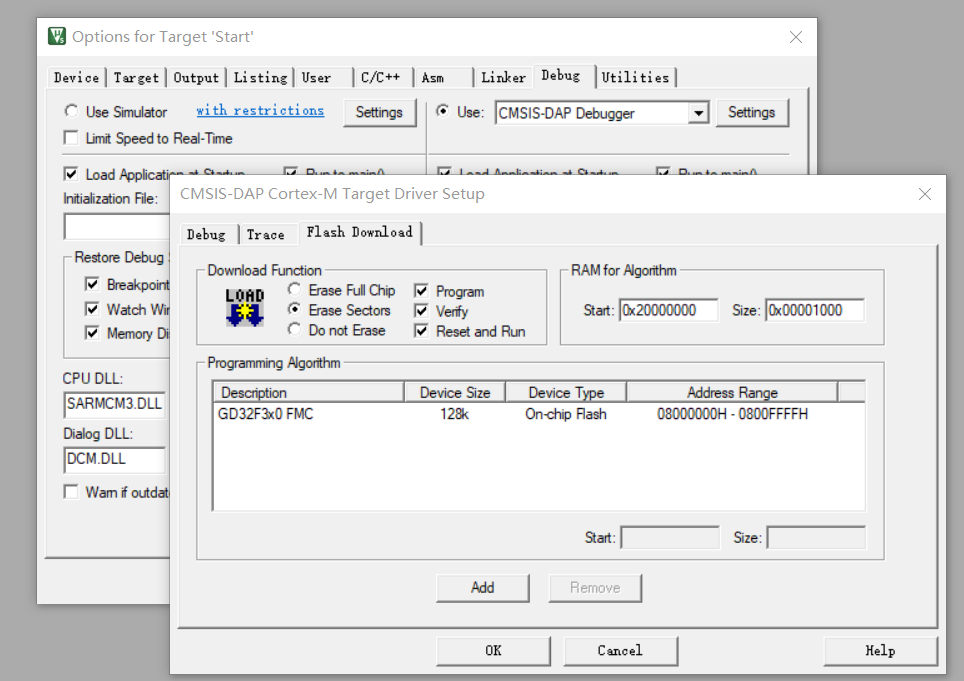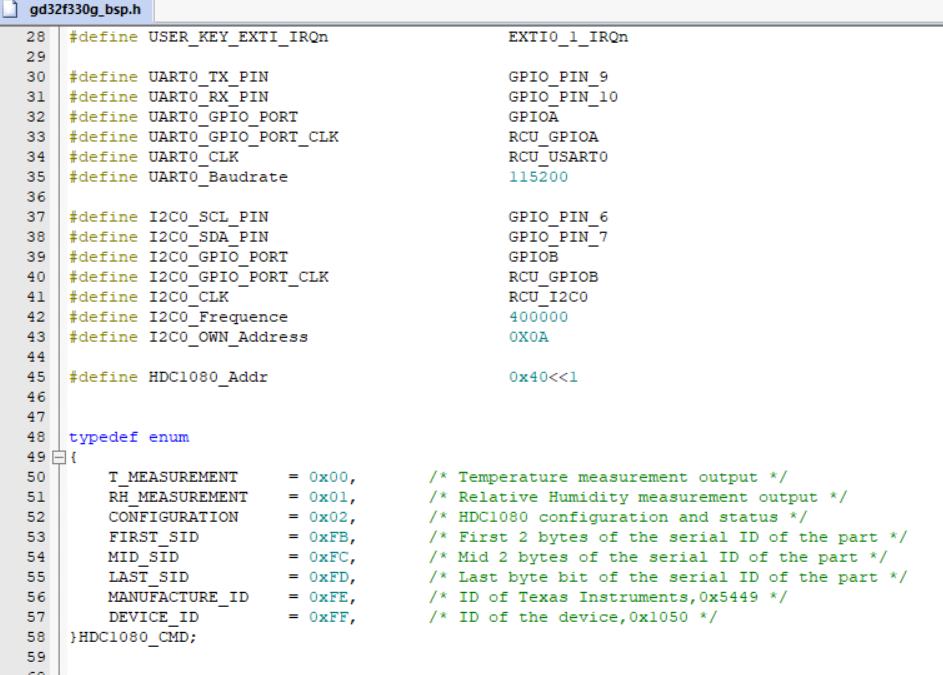非常感谢极术社区和GigaDevice给我机会可以进行GD32F310G-START开发板的试用,也感谢极术小姐姐,物流非常给力。
我拿到的开发板实际板载的MCU是GD32F310G8,QFN28pin封装,基于ARM CORTEX M4内核,主频72MHz,芯片内置64KB flash,8KB SRAM,两路I2C外设。
本次试用目的是利用GD32F310的I2C0实现对HDC1080的初始化及读取环境温湿度,并利用UART口在电脑上显示出来。
1、新建工程
①首先建立一个新的项目文件夹,并在此文件夹下建立对应子文件夹,我建立的文件如下图所示,这个依个人习惯会有不同:
② Document文件夹中存放对项目的说明文件readme.txt;将系统支持包中的GD32F3x0_Firmware_Library_V2.2.0/Firmware文件夹中的内容复制到Libraries文件夹中;Listing/Output文件夹用于存放项目编译时生成的目标文件及list文件,在MDK的魔术棒中进行设置路径;users文件夹中存放main文件及我们自已写的代码;Project文件夹中存放MDK项目文件;
③打开MDK keil5,首先要先导入GD32F310G文件支持包。
④建立新的项目,选择所使用的MCU,我们选择GD32F330G8,如下图所示
⑤新项目中建立如下文件组,并导入启动文件和外设支持包。
⑥点击魔术棒工具进行项目设置。在C/C++选项中添加include文件路径;
⑦点击Debug选项进行GDLink的设置,要选择CMSIS_DAP Debugger,并将Reset and Run打勾。
⑧这样整个项目的配置基本就结束了,可以在main.c文件中建立一个空循环,编译测试项目建立是否正确无误。
2、硬件映射
硬件映射的目的是按目前的硬件连接建立.h文件,如下图所示:
因此基于开发板I2C0采用的是PB6/PB7引脚,因为需要打印读出的值,UART0使用的是PA9/PA10引脚。
3、编写代码
①UART0初始化和printf函数重定向:
void UART_TypeInit(void)
{
gpio_deinit(UART0_GPIO_PORT);
usart_deinit(USART0);
rcu_periph_clock_enable(UART0_GPIO_PORT_CLK);
gpio_mode_set(UART0_GPIO_PORT,GPIO_MODE_AF,GPIO_PUPD_NONE,UART0_TX_PIN | UART0_RX_PIN);
gpio_output_options_set(UART0_GPIO_PORT,GPIO_OTYPE_OD,GPIO_OSPEED_MAX,UART0_TX_PIN | UART0_RX_PIN);
gpio_af_set(UART0_GPIO_PORT,GPIO_AF_1,UART0_TX_PIN | UART0_RX_PIN);
rcu_periph_clock_enable(UART0_CLK);
usart_baudrate_set(USART0,UART0_Baudrate);
usart_parity_config(USART0,USART_PM_NONE);
usart_word_length_set(USART0,USART_WL_8BIT);
usart_stop_bit_set(USART0,USART_STB_1BIT);
usart_enable(USART0);
usart_transmit_config(USART0,USART_TRANSMIT_ENABLE);
usart_receive_config(USART0,USART_RECEIVE_ENABLE);
}
/* retarget the C library printf function to the USART */
int fputc(int ch, FILE *f)
{
usart_data_transmit(USART0, (uint8_t)ch);
while(RESET == usart_flag_get(USART0,USART_FLAG_TBE));
return ch;
}②I2C0外设初始化:
void I2C0_TypeInit(void)
{
gpio_deinit(I2C0_GPIO_PORT);
i2c_deinit(I2C0);
rcu_periph_clock_enable(I2C0_GPIO_PORT_CLK);
gpio_mode_set(I2C0_GPIO_PORT,GPIO_MODE_AF,GPIO_PUPD_NONE,I2C0_SCL_PIN | I2C0_SDA_PIN);
gpio_output_options_set(I2C0_GPIO_PORT,GPIO_OTYPE_OD,GPIO_OSPEED_MAX,I2C0_SCL_PIN | I2C0_SDA_PIN);
gpio_af_set(I2C0_GPIO_PORT,GPIO_AF_1,I2C0_SCL_PIN | I2C0_SDA_PIN);
rcu_periph_clock_enable(I2C0_CLK);
i2c_clock_config(I2C0,I2C0_Frequence,I2C_DTCY_2);
i2c_mode_addr_config(I2C0,I2C_I2CMODE_ENABLE,I2C_ADDFORMAT_7BITS,I2C0_OWN_Address);
i2c_enable(I2C0);
i2c_ack_config(I2C0,I2C_ACK_ENABLE);
}③读寄存器操作:
void I2C0_Register_Read(uint8_t* B_buffer, uint8_t read_address,uint16_t number_of_byte)
{
/* wait until I2C bus is idle */
while(i2c_flag_get(I2C0, I2C_FLAG_I2CBSY));
if(2 == number_of_byte){
i2c_ackpos_config(I2C0,I2C_ACKPOS_NEXT);
}
/* send a start condition to I2C bus */
i2c_start_on_bus(I2C0);
/* wait until SBSEND bit is set */
while(!i2c_flag_get(I2C0, I2C_FLAG_SBSEND));
/* send slave address to I2C bus */
i2c_master_addressing(I2C0, HDC1080_Addr, I2C_TRANSMITTER);
/* wait until ADDSEND bit is set */
while(!i2c_flag_get(I2C0, I2C_FLAG_ADDSEND));
/* clear the ADDSEND bit */
i2c_flag_clear(I2C0, I2C_FLAG_ADDSEND);
/* wait until the transmit data buffer is empty */
while(SET != i2c_flag_get( I2C0 , I2C_FLAG_TBE));
/* enable I2C0*/
i2c_enable(I2C0);
/* send the EEPROM's internal address to write to */
i2c_data_transmit(I2C0, read_address);
/* wait until BTC bit is set */
while(!i2c_flag_get(I2C0, I2C_FLAG_BTC));
delay_1ms(20);
/* send a start condition to I2C bus */
i2c_start_on_bus(I2C0);
/* wait until SBSEND bit is set */
while(!i2c_flag_get(I2C0, I2C_FLAG_SBSEND));
/* send slave address to I2C bus */
i2c_master_addressing(I2C0, HDC1080_Addr, I2C_RECEIVER);
if(number_of_byte < 3){
/* disable acknowledge */
i2c_ack_config(I2C0,I2C_ACK_DISABLE);
}
/* wait until ADDSEND bit is set */
while(!i2c_flag_get(I2C0, I2C_FLAG_ADDSEND));
/* clear the ADDSEND bit */
i2c_flag_clear(I2C0,I2C_FLAG_ADDSEND);
if(1 == number_of_byte){
/* send a stop condition to I2C bus */
i2c_stop_on_bus(I2C0);
}
/* while there is data to be read */
while(number_of_byte){
if(3 == number_of_byte){
/* wait until BTC bit is set */
while(!i2c_flag_get(I2C0, I2C_FLAG_BTC));
/* disable acknowledge */
i2c_ack_config(I2C0,I2C_ACK_DISABLE);
}
if(2 == number_of_byte){
/* wait until BTC bit is set */
while(!i2c_flag_get(I2C0, I2C_FLAG_BTC));
/* send a stop condition to I2C bus */
i2c_stop_on_bus(I2C0);
}
delay_1ms(1);
/* wait until the RBNE bit is set and clear it */
if(i2c_flag_get(I2C0, I2C_FLAG_RBNE)){
/* read a byte from the EEPROM */
*B_buffer = i2c_data_receive(I2C0);
/* point to the next location where the byte read will be saved */
B_buffer++;
/* decrement the read bytes counter */
number_of_byte--;
}
}
/* wait until the stop condition is finished */
while(I2C_CTL0(I2C0)&0x0200);
/* enable acknowledge */
i2c_ack_config(I2C0, I2C_ACK_ENABLE);
i2c_ackpos_config(I2C0, I2C_ACKPOS_CURRENT);
}④写寄存器操作:
void I2C0_Byte_Write(uint8_t* P_buffer, uint8_t write_address)
{
uint8_t i;
/* wait until I2C bus is idle */
while(i2c_flag_get(I2C0, I2C_FLAG_I2CBSY));
/* send a start condition to I2C bus */
i2c_start_on_bus(I2C0);
/* wait until SBSEND bit is set */
while(!i2c_flag_get(I2C0, I2C_FLAG_SBSEND));
/* send slave address to I2C bus */
i2c_master_addressing(I2C0, HDC1080_Addr, I2C_TRANSMITTER);
/* wait until ADDSEND bit is set */
while(!i2c_flag_get(I2C0, I2C_FLAG_ADDSEND));
/* clear the ADDSEND bit */
i2c_flag_clear(I2C0,I2C_FLAG_ADDSEND);
/* wait until the transmit data buffer is empty */
while(SET != i2c_flag_get(I2C0, I2C_FLAG_TBE));
/* send the EEPROM's internal address to write to : only one byte address */
i2c_data_transmit(I2C0, write_address);
/* wait until BTC bit is set */
while(!i2c_flag_get(I2C0, I2C_FLAG_BTC));
for(i=0;i<2;i++)
{
/* send the byte to be written */
i2c_data_transmit(I2C0, *(P_buffer+i));
/* wait until BTC bit is set */
while(!i2c_flag_get(I2C0, I2C_FLAG_TBE));
}
/* send a stop condition to I2C bus */
i2c_stop_on_bus(I2C0);
/* wait until the stop condition is finished */
while(I2C_CTL0(I2C0)&0x0200);
}⑤对HDC1080进行初始化并读取其ID:
void HDC1080_Init(void)
{
uint8_t IDBuffer[2]={0};
uint8_t InitSetup[2]={0x90,0x00};
uint32_t SID[3]={0},MID=0,DID=0;
I2C0_Byte_Write(InitSetup,CONFIGURATION);
delay_1ms(20);
I2C0_Register_Read(IDBuffer,DEVICE_ID,2);
DID = (((uint32_t)IDBuffer[0])<<8 | IDBuffer[1]);
printf("The DeviceID is 0x%x\n\r",DID);
I2C0_Register_Read(IDBuffer,MANUFACTURE_ID,2);
MID = ((uint16_t) IDBuffer[0]<<8 | IDBuffer[1]);
printf("The ManufactureID is 0x%x\n\r",MID);
I2C0_Register_Read(IDBuffer,FIRST_SID,2);
SID[0] = ((uint16_t) IDBuffer[0]<<8 | IDBuffer[1]);
I2C0_Register_Read(IDBuffer,MID_SID,2);
SID[1] = ((uint16_t) IDBuffer[0]<<8 | IDBuffer[1]);
I2C0_Register_Read(IDBuffer,LAST_SID,2);
SID[2] = ((uint16_t) IDBuffer[0]<<8 | IDBuffer[1]);
printf("The First bytes of the serial ID of the part is 0x%x\n\r",SID[0]);
printf("The MID bytes of the serial ID of the part is 0x%x\n\r",SID[1]);
printf("The Last bytes of the serial ID of the part is 0x%x\n\r",SID[2]);
printf("\n\r");
}⑥读取温湿度值并转换成十进制显示:
void readSensor(void)
{
//holds 2 bytes of data from I2C Line
uint8_t Buffer_Byte[2];
//holds the total contents of the temp register
uint16_t temp,hum;
//holds the total contents of the humidity register
double temperature=0,humidity=0 ;
I2C0_Register_Read(Buffer_Byte,T_MEASUREMENT,2);
temp = (((uint32_t)Buffer_Byte[0])<<8 | Buffer_Byte[1]);
temperature = (double)(temp)/(65536)*165-40;
printf("The temperature is %.2f\n\r",temperature);
I2C0_Register_Read(Buffer_Byte,RH_MEASUREMENT,2);
hum = (((uint32_t)Buffer_Byte[0])<<8 | Buffer_Byte[1]);
humidity = (double)(hum)/(65536)*100;
printf("The humidity is %.2f%%\n\r",humidity);
}⑦main函数:
/*!
\brief main function
\param[in] none
\param[out] none
\retval none
*/
int main(void)
{
/* configure periphreal */
systick_Init();
LED_TypeInit();
// NVIC_config();
// KEY_EXTI_TypeInit();
UART_TypeInit();
I2C0_TypeInit();
printf("**********DEMO START**********\n\r");
printf("******************************\n\r");
HDC1080_Init();
while(1)
{
readSensor();
delay_1ms(1000);
}
}4、编译下载
①Build项目文件:
②没有错误,直接下载到开发板中,可以打开串口看到读出温湿度每隔1S读一次并打印出来,与环境温度计比较取值还是比较准确的。
5、试用总结
GD32F310G8芯片采用4x4 QFN28封装,结构可以设计相当紧凑,软件开发资源也是很丰富,虽然功能不算特别强大,但主流的外设基本都有囊括,在目前国产替代的大环境之下,应用前景还是相当广泛的。
对本项目有兴趣的伙伴可以通过百度网盘下载相关源码:
链接:https://pan.baidu.com/s/1rQnTQp2gdUaw_zh8G08yMg
提取码:9sas


